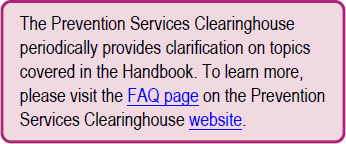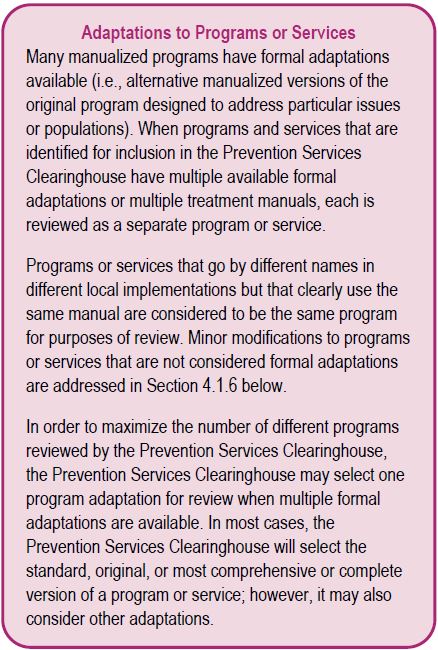 This section describes the criteria for determining whether programs and services under consideration are eligible for inclusion in the Prevention Services Clearinghouse.
This section describes the criteria for determining whether programs and services under consideration are eligible for inclusion in the Prevention Services Clearinghouse.
2.1.1 Program or Service Areas
Title IV-E of the Social Security Act describes four program or service areas—mental health prevention and treatment programs or services, substance abuse prevention and treatment programs or services, in-home parent skill-based programs or services, and kinship navigator programs. Programs and services may be eligible for Prevention Services Clearinghouse review in more than one of these program or service areas.
Mental Health Prevention and Treatment Programs and Services
Eligible mental health programs and services include those that aim to reduce or eliminate behavioral and emotional disorders or risk for such disorders. Included programs and services may target any mental health issue. It is not required that participants in the program or service have a Diagnostic and Statistical Manual (DSM) or International Statistical Classification of Diseases (ICD) diagnosis. Eligible programs and services can be delivered to children and youth, adults, or families; can employ any therapeutic modality, including individual, family, or group; and, may have any therapeutic orientation, such as cognitive, cognitive-behavioral, psychodynamic, structural, narrative, etc. Programs and services that rely on psychotropic medications or screening procedures without a counseling or behavioral therapeutic component are not eligible (e.g., a treatment that uses methylphenidate or lisdexamfetamine for treatment of Attention Deficit Hyperactivity Disorder without an accompanying therapeutic element).
Substance Abuse Prevention and Treatment Programs and Services
Eligible substance abuse prevention and treatment programs and services include those that have an explicit focus on the prevention, reduction, treatment, remediation, and/or elimination of substance use, misuse, or exposure in general. Included programs and services can target any specific type of substance, multiple substances, or aim to address substance use or misuse in general. Programs and services targeting use or misuse of alcohol, marijuana, illicit drugs, or misuse of prescription or over-the-counter drugs are eligible. Eligible programs and services can be delivered to children and youth, adults, or families. Programs and services aimed solely at reducing, treating, or remediating tobacco use (including smoking, chewing tobacco, and vaping) among adults are not eligible. Eligible programs and services can employ any therapeutic modality, including individual, family, or group and may have any therapeutic orientation, such as cognitive, cognitive-behavioral, psychodynamic, structural, narrative, etc. Programs and services may include use of pharmacological treatment approaches. Not eligible are programs and services that are directed only at collateral persons or caregivers, or systems interventions that would not generally be recognized as client-oriented substance use treatment. Additionally, programs and services that are pre-clinical programs (e.g., screening or brief programs aimed solely at getting people into treatment) and that do not themselves involve prevention or treatment are not eligible. However, brief programs that do involve prevention or treatment (i.e., make some attempt to address substance use) are eligible. Programs and services that solely rely on pharmacological interventions without a therapeutic component are not eligible (e.g., a treatment that uses methadone for the treatment of opioid addiction without an accompanying therapeutic element).
Exhibit 2.1 provides some examples of eligible and ineligible programs and services in this area.
Exhibit 2.1. Examples of Substance Abuse Prevention and Treatment Programs and Services
| Eligible Examples | Not Eligible Examples |
|---|---|
| A program that is delivered in a group setting for adolescents who were identified as having either marijuana use or prescription pill misuse within the prior 30 days. | A program that does not work directly with the youth but intervenes with the adults in the youth’s life to ensure that there is adequate supervision and monitoring to limit access to substances and substance using peers. |
| A program treating mothers who are misusing opioids using a combination of methadone, cognitive behavioral therapy, and peer support. | A standalone screening program that uses social norming to attempt to motivate people to seek treatment. |
| A brief, 30 minute motivational intervention that is delivered in emergency rooms after a patient is seen for a drug overdose. | A program that uses the medication acamprosate to reduce withdrawal symptoms for adults with alcohol use disorder without an accompanying therapeutic component. |
In-Home Parent Skill-Based Programs and Services
Eligible parent skill-based programs and services include those that are psychological, educational, or behavioral interventions or treatments, broadly defined, that involve direct intervention with a parent or caregiver. Direct intervention contact means that intervention services are provided directly to the parent(s) or caregiver(s); children may be present or involved, but are not required to be present for a program to be eligible. Contact may be face-to-face, over the telephone or video, or online. Programs may be explicitly delivered as in-home interventions or can be interventions for which delivery in-home is a possible or recommended method to administer the intervention. This may include residential facilities, shelters, or prisons if that is where the parent(s) or caregiver(s) resides.
Exhibit 2.2 provides some examples of eligible and ineligible programs and services in this area.
Exhibit 2.2. Examples of In-Home Parent Skill-Based Programs and Services
| Eligible Examples | Not Eligible Examples |
|---|---|
| A program that is delivered in the family home in individual sessions for 12 weeks. Both the parent and the child attend and the parent is coached to use different skills with the child during the session. | An aggression reduction training for parents of adolescents that is delivered in small groups for 10 weeks and in-home delivery is not possible.* |
| An on-line parenting program that helps parents set goals and match their parenting goals with evidence-based parenting strategies. | A public service campaign that focuses on positive parenting practices is delivered in a community using television and radio spots, public posters and billboards, and direct mailings. |
*This example could be considered within the mental health program or service area.

Eligible kinship navigator programs and services include those focused on assisting kinship caregivers in learning about, finding, and using programs and services to meet the needs of the children and youth they are raising and their own needs, and that promote effective partnerships among public and private agencies to ensure kinship caregiver families are served. Support services may include any combination of financial supports, training or education, support groups, referrals to other social, behavioral, or health services, and assistance with navigating government and other types of assistance, financial or otherwise.
Kinship caregivers may be a grandparent or other relative as well as tribal kin, extended family and friends or other “fictive kin” who are caring for children. Kinship care relationships may be formal or informal.
Programs that involve helping members of the general public access services, irrespective of whether they are caregivers or not, are not eligible.
2.1.2 Book/Manual/Writings Available
To be eligible for the Prevention Services Clearinghouse, programs and services in any of the four program or service areas must be clearly defined and replicable. To meet this criterion, programs and services must have available written protocols, manuals, or other documentation that describes how to implement or administer the practice. Protocols, manuals, or other documentation must be available to the public to download, request, or purchase. Programs and services that require training, certification, or other prerequisites to access manuals or other documentation would meet this criterion.
For each program or service considered for inclusion in the Prevention Services Clearinghouse, reviewers record whether the program or service explicitly aims to impact each of the target outcomes; whether it is currently in active use; and whether there are implementation and fidelity supports available in addition to a manual or protocol. Reviewers make these determinations by reviewing available documentation and websites, though they may also consult research studies or program developers to gather additional information. The Prevention Services Clearinghouse also prioritizes programs and services in a way that ensures representation of programs and services across the four program or service areas: mental health prevention and treatment programs and services, substance abuse prevention and treatment programs and services, and in-home parent skill-based programs and services, as well as kinship navigator programs.
2.2.1 Target Outcome Domains
Programs and services in the areas of mental health, substance abuse, and in-home parent skills must target outcomes in the domains of (a) Child Safety, (b) Child Permanency, (c), Child Well-Being, and/or (d) Adult Well-Being.
Programs and services in the area of kinship navigator must target outcomes in the domains of (a) Child Safety, (b) Child Permanency, (c) Child Well-Being, (d) Adult Well-Being, (e) Access to Services, (f) Referral to Services, and/or (g) Satisfaction with Programs and Services. Operational definitions for the eligible target outcomes are provided in Section 4.1.5.
2.2.2 In Use/Active
The Prevention Services Clearinghouse prioritizes programs or services that are in active use. This means that they must be currently available or delivered with a book, manual, or other documentation available in English. Programs and services that are no longer actively used, are defunct or discontinued, or are otherwise not currently practiced or delivered would not meet this criterion.
2.2.3 Existence of Implementation and Fidelity Supports
The Prevention Services Clearinghouse prioritizes programs and services for which there are implementation supports, implementation manuals or frameworks, fidelity checklists or other fidelity-monitoring tools, videos, training programs, coaching programs, or any similar resources available for potential program adopters. To meet this criterion, there must be affirmative, documented evidence that such supports are available to the public in English, either at no cost or for purchase.

